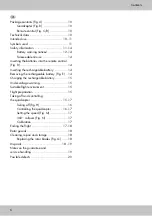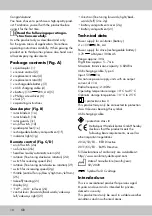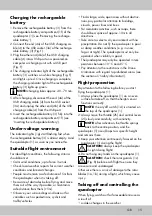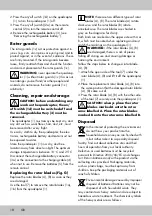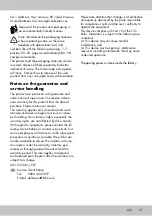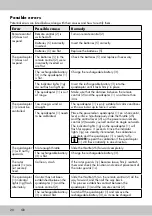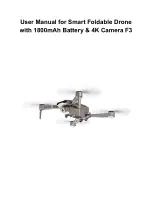
16
• sudden changes in wind (gusts)
• loss of visibility
• direct sunshine (overheating, loss of flight con-
trol due to impaired vision)
Taking off (Fig. H)
1. Press the on/off (switch) (2a) on the remote
control (2) to turn the remote control on. The
display lights (2j) flash.
NOTE:
always switch the remote control (2)
on first.
2. Insert the rechargeable battery (3) into the
rechargeable battery compartment (1f) of the
quadcopter (1).
3. Press the on/off switch (1d) on the quadcopter
(1) to turn the quadcopter (1) on. The indicator
lights (1g) of the quadcopter (1) flash alternate-
ly and a signal tone is emitted from the remote
control (2).
4. Slide the throttle (2h) all the way forward, and
then all the way back.
NOTE:
this process establishes contact
between the quadcopter (1) and the remote
control (2).
If the throttle (2h) is not first moved forward and
then back, the quadcopter (1) remains secured
and will not be ready for flight. Acoustic signals
are emitted from the remote control (2).
The indicator lights (1g) on the quadcopter (1)
light up continuously. The quadcopter (1) is now
ready for flight.
NOTE:
the display (2j) shows the speed and
‘NORMAL’ mode.
5. Press the ‘START/LAND’ button (2i) located at
the front of the remote control. The rotor blades
will start to turn.
Controlling the quadcopter
The integrated height sensor ensures that the
quadcopter (1) automatically maintains a steady
height, and it facilitates initial flight manoeuvres.
You have several control options:
• Ascending/descending (throttle) (Fig. I)
By pressing the throttle (2h) forwards, the rota-
tional speed of the rotors (1a, 1b) is increased.
The quadcopter (1) will then begin to ascend.
By moving the throttle (2h) backwards, the rota-
tional speed of the rotors (1a, 1b) is decreased.
The quadcopter (1) will then begin to descend.
• Turning left/right (yaw rotation) (Fig. J)
By moving the throttle (2h) to the left or right,
the quadcopter (1) rotates on the vertical axis,
i.e. the quadcopter (1) rotates to the left or
right.
• Moving forwards/backwards (pitch)
(Fig. K)
• By moving the control lever (2l) forwards or
backwards, the quadcopter (1) moves in the
corresponding direction.
• Hovering left/right (roll) (Fig. L)
If you want to perform a movement to the right
or left without rotating the quadcopter (1), i.e.
hover sideways, move the right control lever (2l)
to the left or right.
• Turning (yaw trimming) (Fig. O)
If the quadcopter (1) moves around its own
axis of its own accord without you moving
the throttle (2h), you can correct this with the
yaw-trimming.
If the quadcopter (1) is turning clockwise, press
the yaw-trim button to the left (2f), and if it is
turning anti-clockwise, press the trim button to
the right (2d). In this way you counter the yaw
movement by trimming in the opposite direction.
• Direction (roll and pitch trim) (Fig. P)
If there is a forwards or backwards movement,
even though you are not using the control lever
(2l) at all, you can correct this by pitch trim-
ming. If the quadcopter (1) is flying forwards,
press the pitch-trim button (2o) and vice versa
(2m). You can counteract the unwanted move-
ment with the trim setting.
If the quadcopter (1) moves sideways of its own
accord, you can correct this by roll trimming.
If the quadcopter hovers to the left (1) side-
ways, press the trimming button (2n) to the right
and vice versa (2p). This allows you to counter-
act the unwanted movement.
• Headless mode (Fig. Q)
This refers to a flight aid that when activated
enables the quadcopter (1) to always fly in the
direction it is steered. It is recommended for
pilots with little flying experience.
GB




